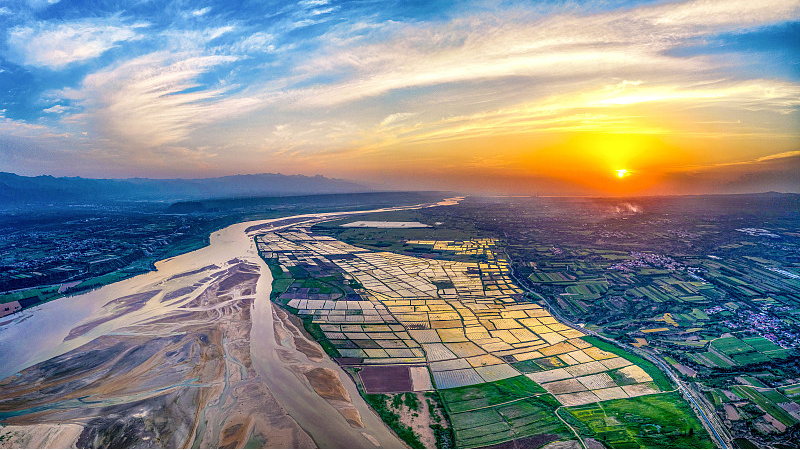
Yuncheng, Shanxi Province, China. /CFP
Yuncheng, Shanxi Province, China. /CFP
Editor's note: Xin Ge is an associate professor at the School of Public Economics and Administration, Shanghai University of Finance and Economics. The article reflects the author's opinions and not necessarily the views of CGTN.
On a trip to Xi'an, the capital of Shaanxi Province, where the China-Central Asia Summit is being held, Chinese President Xi Jinping, also the general secretary of the Communist Party of China (CPC) Central Committee, stopped over in Yuncheng of Shanxi Province and underscored ecological and cultural heritage protection in the Yellow River basin on the afternoon of May 16, 2023.
President Xi inspected the Museum of Yuncheng and Yuncheng Salt Lake. The city of Yuncheng is located at the southernmost tip of Shanxi Province, which boasts a long history with rich cultural elements and obtained its name from the "city of salt transport."
While May 18 is International Museum Day, a visit to the Museum of Yuncheng adds special significance to this inspection tour. As President Xi has on many occasions noted, cultural heritage protection is important, and "every museum is a big school." At the museum, Xi learned in detail about the early historical development of Chinese civilization in Yuncheng and received a detailed briefing on the formation and historical evolution of Yuncheng Salt Lake.
Valuable cultural relics in the Yuncheng Museum, some of which are national treasures, are witnesses to the Chinese history of humanity, culture, and civilization, he said.
He called for further efforts to advance the national research project on tracing the origins of Chinese civilization and the historical research on this civilization to improve the capabilities of protecting and utilizing cultural relics and passing on Chinese cultural heritage.

Volunteers explain painting and calligraphy works in Yuncheng, China's Shanxi Province, April 16, 2023. /CFP
Volunteers explain painting and calligraphy works in Yuncheng, China's Shanxi Province, April 16, 2023. /CFP
The city of Yuncheng is also famous for its salt lake, popularly referred to as "China's Dead Sea." Covering an area of 132 square kilometers, the lake is one of the only three inland salt lakes on this planet containing sodium sulfate. Its amount of salt is similar to that of the Dead Sea and allows humans to float on the lake.
According to geologists, the lake was formed about 50 million years ago and has a mining history of more than 4,600 years. In recent years, the local area insisted on prioritizing protection and green development and implemented the policy of "returning salt to gain lake," i.e. stopping all industrial production within the salt lake protection area and promoting industrial transformation and upgrading per local conditions.
President Xi noted that the ecological values and function of the salt lake are becoming increasingly important, urging coordinated efforts to protect and utilize it to further protect its historical and cultural values.
From a broader perspective, the significance of the protection of the Yellow River basin cannot be overemphasized. Known as the "mother river" of the Chinese nation and the cradle of Chinese civilization, a large number of archaeological discoveries have proven that the Yellow River basin was the main area of early human activity in China and had been an economic, political, and cultural center for thousands of years. Nowadays, despite containing merely 2 percent of river runoff in China, the 5464 km long waterway feeds about 12 percent of China's population and irrigates 15 percent of all arable land in China.
While the ecological warning line of river basins is 40 percent of the utilization ratio of the water source, the Yellow River Basin has reached as high as 80 percent – the shortage of water sources has been a severe problem for the Yellow River. Moreover, the basin is fragile in ecology. Thanks to the continued conservation efforts, many places along the waterway, which used to suffer from sandstorms, saline and alkali soils, and flooding have been greatly improved.
Furthermore, large wind power and photovoltaic bases have been constructed on the desert and the Gobi of the basin. The total installed capacity reached 140 million kilowatts and 120 million kilowatts for wind power and photovoltaic respectively, accounting for 46.7 percent and 43.3 percent of the nation's overall capacity.
It is worth noting that the Yellow River Protection Law has been effective since April 1, 2023. The law was formally ratified by the Standing Committee of China's National People's Congress in October 2022. According to the first general provision of the law, it aims to strengthen the Yellow River basin's ecological protection and promote the river's calm and harmlessness, the efficiency and intensive use of water resources, high-quality development, and its cultural heritage.
This action follows the law to protect China's longest river, Yangtze River, in effect on March 1, 2021, showing that China has scaled up efforts in recent years to protect the ecological environment and cultural heritage in the river basins, and has become a bellwether in transforming an industrial civilization into an ecological friendly one.
(If you want to contribute and have specific expertise, please contact us at opinions@cgtn.com. Follow @thouse_opinions on Twitter to discover the latest commentaries in the CGTN Opinion Section.)